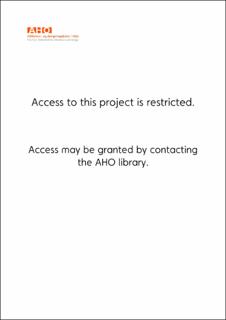| dc.contributor.advisor | Hølmebakk, Beate | |
| dc.contributor.advisor | Engh, Chris-Johan | |
| dc.contributor.author | Svarstad, Silje Breistein | |
| dc.coverage.spatial | Middelalderparken, Gamlebyen, Oslo, Norge | en_US |
| dc.date.accessioned | 2023-02-21T08:02:38Z | |
| dc.date.available | 2023-02-21T08:02:38Z | |
| dc.date.issued | 2022-12 | |
| dc.identifier.uri | https://hdl.handle.net/11250/3052519 | |
| dc.description | «The project is the result of a study of a composite scenario where partly antagonistic fields must be considered against each other in order to sketch a convincing architectural strategy for an open storage museum programme. These considerations are linked to conservation, curation, archeology, visitors, city development, and the city antiquity. The project uses Lokomotivverkstedet in the Medieval Park in Oslo as a place to study and evolve the architectural strategy. The existing building is approached by focusing on crucial maintenance and repair work. Individual acclimatized storage rooms house the permanent collection. The storages are inserted into the existing building by adding a secondary skeleton-structure. The in-between space of the acclimatized storages and the existing building function as circulation and temporary exhibition space.
Museums worldwide typically showcase between 2 and 4 percent of their collections. The remaining 96 percent is hidden in storage, typically in the museum itself or on the outskirts of the city. Museum collections are increasingly digitalized and made “open to the public, accessible and inclusive” as the ICOM museum definition states. Whether digitalized or not, the collections take up a lot of physical space and is inaccessible to the public.
The reason for the museums not displaying all their artefacts at once is simple – a limitation of display space and costs in connection to conservation and curated exhibitions. It raises the question if artefacts can be exhibited in a more efficient way so that a greater share of the collections are made physically accessible to the public. If so – how? Is the open storage concept a possibility? And what are the downsides of making larger parts of the collections physically accessible?
Big developments, especially initiated by the railway, has worked as catalysts for archeological excavations in Gamle Oslo from mid 1800s. The history of the area of Gamle Oslo, or old Oslo, reaches back to medieval times. The accumulation of archeologically excavated medieval ruins and sites, Oslo being mentioned in the Sagas of the Viking Kings of Norway and archeological finds dated to the medieval period showing traces of connections with central Europe witness that it has been a place of great importance in Norway. By placing a public programme with archeologically excavated medieval artefacts as content in close relation to the medieval ruins and sites and the commenced Medieval Park I aim to create a wholeness and continue to build on the area´s identity.
In the middle of the Medieval Park in Oslo lies what used to be the locomotive workshop (Lokomotivverkstedet) for the railway activity that was, and still is, a significant feature of the area. The building, made from drawings by railway engineer Oxhaal in 1893, is of a an industrial character with neo-gothic brick facades and spacious halls. It holds a public character in the context of Oslo today. The building has been sporadically maintained and is in great need of repair work. Today the building listed as yellow, equivalent to a grade II listing, whilst the ground is listed as red, equivalent to grade I listed. Lokomotivverkstedet has for many years been without a clear use and future plan and has up unitl recently worked as a storage for archeologically excavated artefacts owned by Museum of Cultural History. By making use of the building and inserting an open storage programme many of the objects in the collection will be re-contextualised either to the area where it was excavated from the ground or to where it was earlier stored. | en_US |
| dc.language.iso | eng | en_US |
| dc.publisher | The Oslo School of Architecture and Design | en_US |
| dc.rights | Navngivelse-Ikkekommersiell-DelPåSammeVilkår 4.0 Internasjonal | * |
| dc.rights.uri | http://creativecommons.org/licenses/by-nc-sa/4.0/deed.no | * |
| dc.subject | Architecture | en_US |
| dc.subject | Arkitektur | en_US |
| dc.subject | Lokomotivverkstedet (Oslo) | en_US |
| dc.subject | Museums | en_US |
| dc.subject | Museum | en_US |
| dc.subject | Museer | en_US |
| dc.subject | Offentlige bygninger | en_US |
| dc.subject | Public buildings | en_US |
| dc.title | Open Storage: Museological Artefacts Will Outnumber Us | en_US |
| dc.type | Master thesis | en_US |
| dc.description.version | submittedVersion | en_US |
| dc.rights.holder | Silje Breistein Svarstad | en_US |
| dc.subject.nsi | Architecture and design: 140 | en_US |



